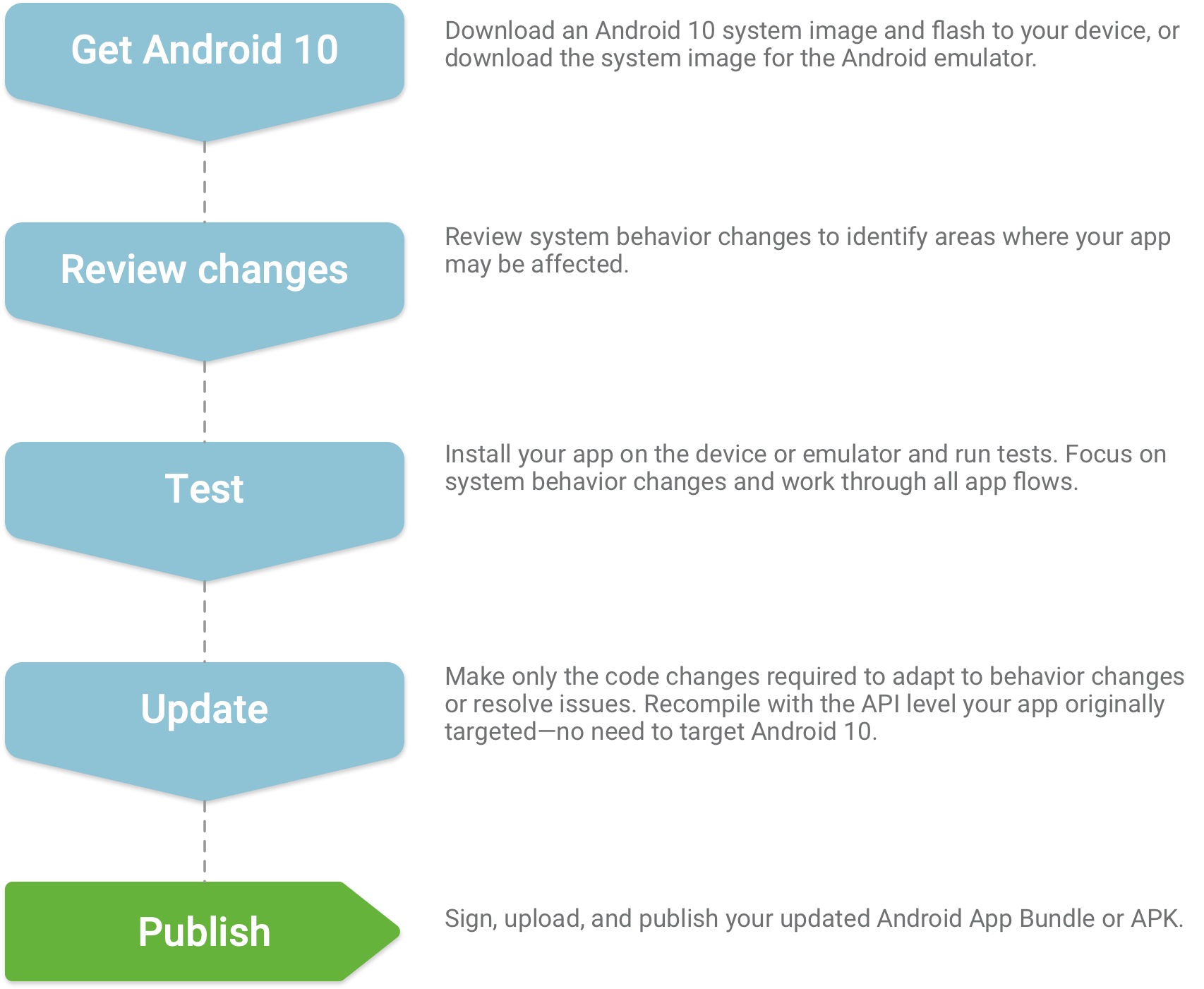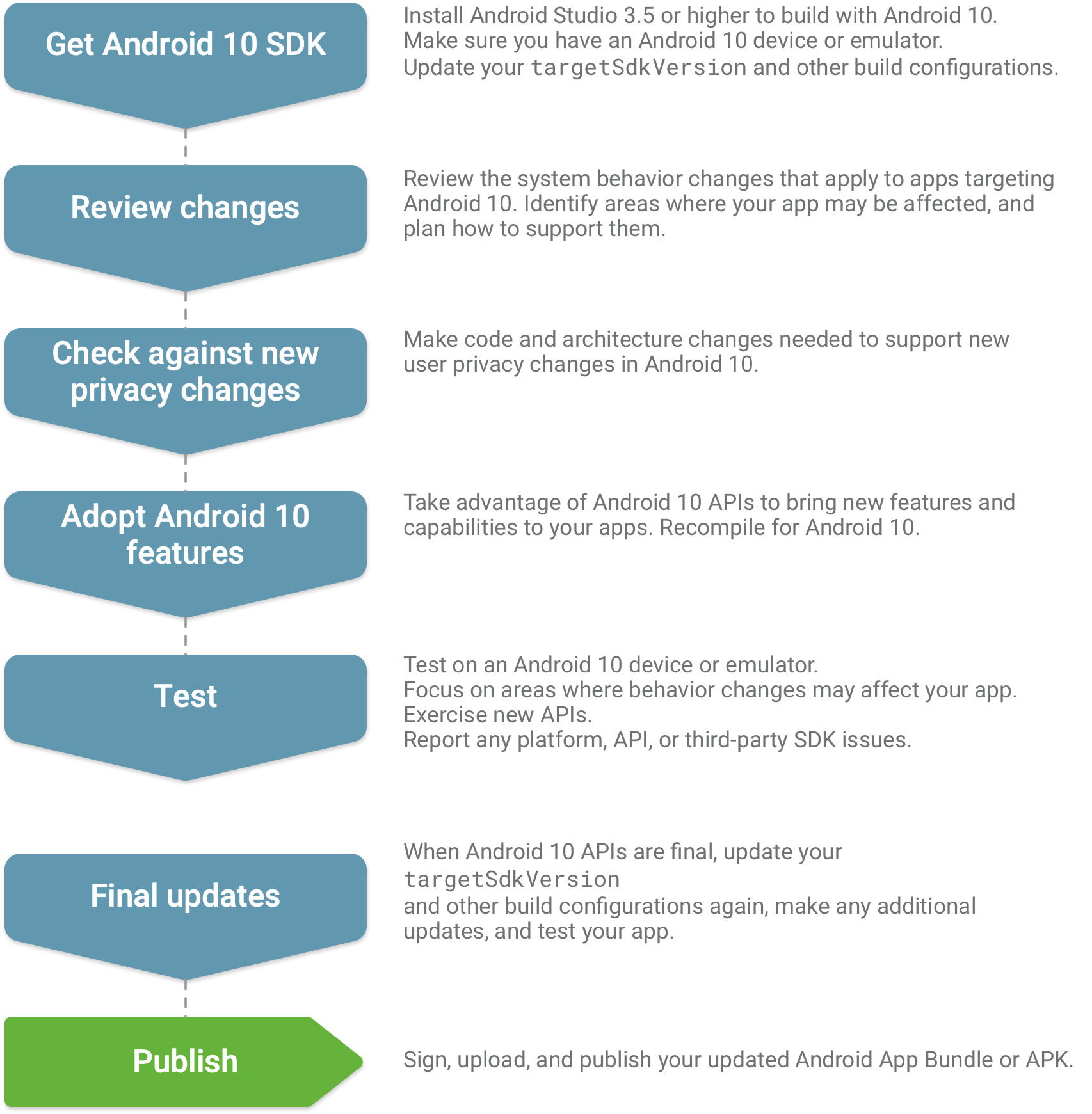환영합니다 Android 10에는 새로운 환경을 구축하기 위한 많은 새로운 API는 물론 Android 10 기기에서 실행 시 앱에 영향을 줄 수 있는 업데이트된 시스템 동작도 있습니다.
시작하려면 시스템 동작 변경사항, 개인 정보 보호 변경사항, 새로운 기능 및 API를 검토한 후 다음 두 단계로 앱을 마이그레이션하는 것이 좋습니다.
- 기본 호환성을 확인합니다. Android 10을 실행하는 새 기기를 구매하거나 업데이트하는 사용자가 게시된 기존 앱을 바로 사용할 수 있는지를 가능한 한 빨리 확인해야 합니다. 앱을 테스트하여 충분히 작동하는지 확인한 다음 앱의 호환 버전을 사용자에게 게시합니다.
- Android 10 기능 및 API로 빌드합니다. 그런 다음 Android 10에서 새로운 기능과 API를 살펴봅니다. 개발 환경을 설정하고, 앱의
targetSdkVersion을 변경하고, 앱과 관련된 새로운 API로 빌드합니다.
다음 섹션에서는 이러한 각 단계에서 해야 할 일을 강조하여 설명합니다. 시작하기 전에 앱을 실행하고 테스트할 하드웨어 기기 또는 에뮬레이터를 준비했는지 확인하세요.
1단계: 기본 호환성
이 단계의 목표는 앱이 Android 10에서 실행될 때 나타날 수 있는 기능 회귀 또는 기타 영향을 식별한 다음 이를 해결하고 사용자에게 업데이트된 버전을 게시하는 것입니다. 호환성 지원을 위해 compileSdkVersion을 선택적으로 변경할 수는 있지만 앱의 targetSdkVersion을 변경하거나 새 API를 사용해서는 안 되는 경우가 많습니다.
일부 플랫폼 변경사항은 앱의 동작에 영향을 줄 수 있으므로 모든 흐름을 통해 기존 앱의 기능을 테스트하는 것이 중요합니다. 호환되는 앱 버전을 게시할 때 업데이트 노트에서 Android 10 지원을 사용자에게 알리는 것이 좋습니다.
사용자가 Android 10으로 원활하게 전환하도록 지원하려면 호환되는 앱 버전을 가능한 한 빨리 게시하는 것이 좋습니다. 기기에서 Android 10 업데이트 수신을 시작하기 전에 하는 것이 가장 바람직합니다.

테스트 수행
호환성 테스트는 앱 출시를 준비할 때 진행하는 테스트와 유형이 동일합니다. 이 시점에서 핵심 앱 품질 가이드라인과 테스트 권장사항을 검토하는 것이 좋습니다.
앱에 영향을 줄 수 있는 알려진 동작 변경사항을 숙지해야 합니다. 이러한 동작 변경사항은 targetSdkVersion을 변경하지 않은 경우에도 앱에 적용됩니다. 변경사항을 미리 검토하면 영향을 받을 수 있는 영역을 식별하여 문제를 더 빨리 디버깅할 수 있습니다.
Android 10에서는 개인 정보 보호가 폭넓게 변경되었으므로, 주요 개인 정보 변경사항을 검토하고 앱에 미칠 수 있는 영향을 파악해야 합니다.
2단계: Android 10으로 빌드
준비가 되면 Android 10의 새로운 기능과 API를 살펴보고 새로운 환경으로 앱을 개선할 수 있습니다. 새 API로 개발을 시작하려면 Android 스튜디오에서 Android 10 (API 29) SDK를 설정하고 targetSdkVersion과 compileSdkVersion을 모두 29로 변경해야 합니다.
targetSdkVersion을 변경할 때는 Android 10(API 29) 이상을 타겟팅할 경우 앱에 적용되는 시스템 동작 변경사항도 고려해야 합니다.
일부 동작 변경사항은 회귀 또는 비정상 종료를 일으킬 수 있으므로, targetSdkVersion을 변경하는 앱 업데이트를 게시하기 전에 변경사항을 검토하고 철저히 테스트해야 합니다.

SDK 다운로드
Android 10으로 앱을 빌드하기 위해 SDK 패키지를 다운로드하려면 Android 스튜디오의 최신 버전을 사용해야 합니다. 자세한 내용은 SDK 설정을 참고하세요.
테스트 수행
앞서 설명한 준비가 완료되면 앱을 빌드한 후 테스트를 통해 Android 10을 타겟팅할 경우 올바르게 작동하는지 확인할 수 있습니다. 이 시점에서 핵심 앱 품질 가이드라인과 테스트 권장사항을 검토하는 것이 좋습니다.
targetSdkVersion을 29로 설정하고 앱을 빌드하는 경우 알아야 하는 특정한 플랫폼 변경사항이 있습니다. Android 10 동작 변경사항 페이지에 설명된 이러한 변경사항 중 일부는 앱 동작에 상당한 영향을 미치거나 앱의 비정상 종료를 일으킬 수 있으며, 이는 아직 새 API를 사용하지 않더라도 마찬가지입니다.

